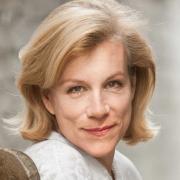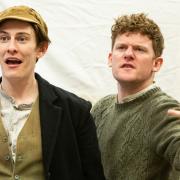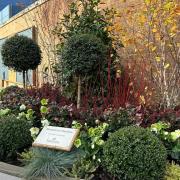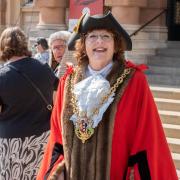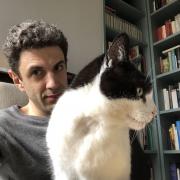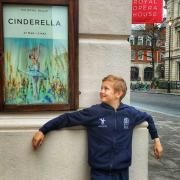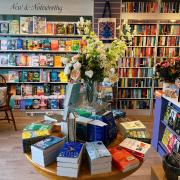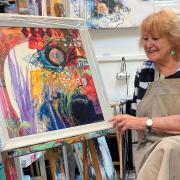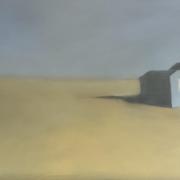Sixty years ago, the Queen's reign was not yet a decade old when she came to Suffolk. The county celebrated in it's own uniquely Suffolk way...
As a way of celebrating Her Majesty the Queen's 70 years on the throne, Suffolk has produced an anthology of words and images that celebrate the county, called A New Suffolk Garland. It's 'new' because the original A Suffolk Garland for the Queen was published in 1961, marking Her Majesty Queen Elizabeth II’s Progress through the county. For the sake of history, it's worth mentioning that Queen Elizabeth I made her first visit to Suffolk 400 years previously, in 1561.
As with so much about glorious Suffolk, the 1961 book was not conventional. It was, rather, a joyous evocation of this most easterly county of the Queen’s realm. Delectable highlights include a cover design from the late Carl Giles, the Daily Express cartoonist whose Ipswich family was central to his work, and a two-page cartoon spread of the Maybush Inn at Waldringfield depicting a Gilesesque waterborne Wacky Races. Pictures of churches, the Suffolk Trinity of livestock, racehorses at Newmarket, wildflowers, oysters at Butley Creek, and Benjamin Britten and Peter Pears in a rowing boat on the meare at Thorpeness are among the pictorial treasures that intersperse the poetry and prose.

Here’s an extract from Silly Suffolk, by Olive Cook. (I believe 'silly' is a word for 'holy'). “The Suffolk people are soft-spoken and kindly, though, like all East Anglians, reserved and sometimes uncomfortably independent… The country speech, a low sing-song has, in the remoter districts, a liveliness and a full flavour which have never been contaminated by urban influences.” “Dew is ‘dag’… fallen apples must not lie too long or they will all go ‘clung’. My grandmother, who lived in Wickhambrook, on one occasion dismissed a smart, new dress thus: ‘How yeow dew go flacketen about.’”
READ: Festival of Suffolk celebrates Queen's Platinum Jubilee
Cook relates the apocryphal story of the labourer and the passing motorist: “ 'Do you know the time?' asked the motorist. After struggling for some minutes to extract his watch from the top pocket of his corduroys, the labourer looked at it carefully, the replied: 'Yes, thank God I dew’, replaced the timepiece and continued his work.” A picture of Monks Eleigh from Witnesham’s master draughtsman, artist Leonard Squirrell, follows an essay on Suffolk’s rivers. His watercolour (reproduced in black and white) is followed by pictures of works by Anna Airy and Sir Cedric Morris. Among those who wrote pieces for the book are authors Hammond Innes and Norah Lofts, historian Norman Scarfe, and countryman writer Adrian Bell.

It isn’t easy to choose tasters from this Suffolk cornucopia but here are a few appetisers to enjoy. Norman Scarfe describes the Queen’s 1961 route through Ipswich after arriving at Shotley. “The royal route passes most of the remarkable fifteenth and sixteenth-century houses in St Peter’s and St Nicholas’ Streets and, above all, in Fore Street. Of the two most delightful buildings in Ipswich, the older, Christchurch Mansion, in its stately, verdant park, the Queen will, alas, not have an opportunity to see. The other is of this moment and Her Majesty has come to open it: the new Civic College.”

George Ewart Evans devotes his pages to folklore. In particular, that of Blaxhall, where playing marbles was popular. “The marble season began in the spring… (and) the season went on until Good Friday when there was a definite rule that the game should stop. If a boy saw another playing marbles any time after Good Friday, he had full licence to rush up to him, seize the marbles and… cry out as he did so: ‘Tom Fobble’s Day!’ Sadly neither the author nor any source that I can find throws light upon the source of this exclamation. (Tom Fobble, please get in touch).



Suffolk’s great agricultural heritage can be prey to sudden unexpected weather events. Doreen Wallace, (in an extract from Willow Farm, courtesy of Messrs Collins) describes one such violent July storm, on a farm near Ipswich. “… a gust of wind sprang up from nowhere… After an interval, there was a strange rustling, rushing noise… darkness descended. All at once there (was) the rushing, the darkness and a frightening clatter like rifle fire, like a salvo of tin cans – like nothing on earth – and with a curiously innocent tinkle, the breaking of glass in an upstairs window.
"(It was) Not dancing hailstones. The things that fell from the sky were standing up on edge, rolling and lying flat. They were little plates of ice. They streamed down in ropes, at an angle, pursued by a high wind.” Ducks, chickens and young turkeys were killed in the onslaught and the sugar beet and corn crops, which had stood in the narrow path of the storm, were cut to ribbons. The entire harvest was gone.
DISCOVER MORE: Get Suffolk magazine every month - here's how to subscribe




